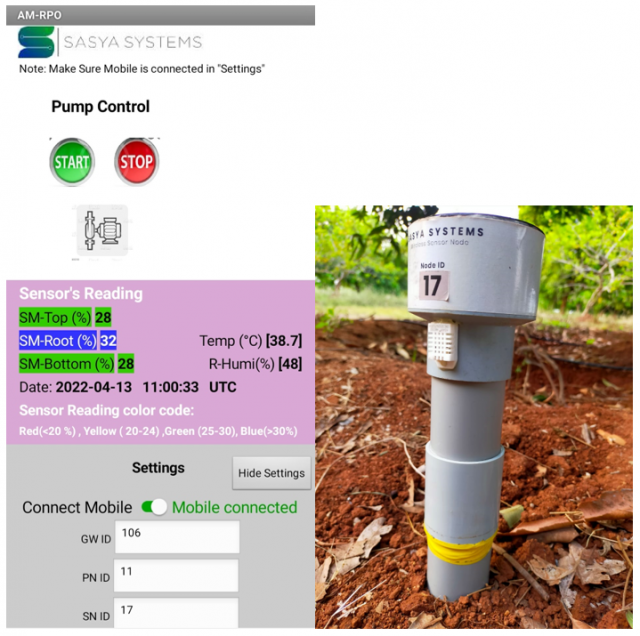his is the second in a series of blogposts describing the development and implementation of water–saving solutions in India. The innovations were developed by KS Gopal, founder and director of the Centre for Environment Concerns. It describes the journey to reduce the use of irrigation water for farming following the 5M concept:
- Moisture at plant root zone (part 1)
- Measured Moisture for water efficiency & savings (part 2)
- Microbes for healthy soils (part 3)
- Mycorrhizae for root health and synergy to maximise plant nutrient uptake (part 3)
- Management of farm operations for confidence and preparedness (part 4)
Since our discussion in the previous blog post, our next issue was of what is the ideal amount of water to be provided to plants? For drip irrigation systems, scientists should know water needs in different soils and at different stages of the plant life cycle. This was the next challenge we addressed on our journey to maximise water savings.
To define and deliver measured root zone moisture levels, it must be based on plant and soil suction requirements. We adopted the pF value as the ideal moisture measurement unit to plan irrigation. The pF value points at the force that plant roots need to exert to adsorb water from the soil. For instance, a pF value of zero indicates the soil is filled with water or over-irrigation, a bane in Indian farming systems, while fully dry soil has a PF of 7.0. Our aim is to maintain a number between 2.8 and 3.2 PF values as ideal soil moisture. PF also offers one guiding parameter for adoption on multiple crops regardless of the soil, species, and plant life cycle.
Our moisture probes provide four colours showing its status: red means dry and needing immediate irrigation, yellow means close to needing irrigation, green shows adequate moisture while blue indicates excess irrigation. This probe instrument is not calibrated for each soil but is an approximate indicator of the moisture status. It helps the farmers to know the moisture status and address their constant anxiety of moisture adequacy, leading to excess water application. It is a useful aid to improve irrigation schedules and save water.
We already achieved remarkable results using SWAR and water meters. When comparing drip irrigated tomato production under plastic mulch with SWAR irrigated systems we observed that SWAR used 15% less water. There was no disease, but it was difficult to justifyit economically for large scale tomato farms. However, the savings are impressive and the operations more feasible when using SWAR in tree plantations. In one example, SWAR was using only 50 liters of water per kilogram of pomegranate when a drip irrigation system would instead use 200 liters per kilogram. This is most likely thanks to the precise water application to the root zone at 1.5 feet depth, less competition with weeds, and decreased evaporation.
The next improvement is setting up an automatic pump that will be switched on by a pF sensor, and it will be turned off when water flow is detected by another sensor along the irrigation laterals. This process will repeat in pulses until the pF sensor measures that sufficient soil moisture is available in the soil. We are thus able to keep the pF value around pF 3 which is optimal for crop development as both water and air (O2) are readily available. The system is solar-powered, low energy radio controlled so that no wiring is required. In case needed, we can automatically and separately irrigate 4 zones.
We vary the location of sensors based on plant species, as their root locations vary and are about 12-15 inches away (study spread) from where SWAR is installed.
The picture below shows a sensor installed near a ten-year-old peak fruit yield age mango tree. Here we place three sensors, first at about six inches into the soil to study capillary moisture spread, next is at the active root zone and about 15 inches to know the moisture and the third is twenty inches or lower to study gravity and drainage conditions. The consequent picture shows reading variations in the moisture levels in the subsoil, as well as ambient temperature and humidity of the embedded sensors. This data updates itself every thirty minutes. At the top is a remote irrigation pump controller for farmers to switch on or off based on moisture data. The picture to the right is a solar-powered sensor node installed in the field from where data gets to the gateway and from where it is sent to the cloud and received in the App provided to the farmer.

Currently, farmers pay a monthly fee for GSM data connectivity but once we determine the depth at which each sensor should be put based on the optimum moisture spread and intensity, we will eliminate recurring costs leading to system cost being very low.
